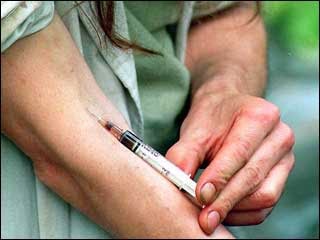In the course of our life, almost all of us use drugs of some sort or another. A drug can be defined as a substance used in the diagnosis, treatment or prevention of a disease or as a component of a medication. A drug can also be defined as a substance that alters the chemistry of our body and consequently affects the natural balance of our mind and emotions. Drugs that can be prescribed by a doctor include substances such as penicillin which are intended to cure infections, sleeping pills, tranquilizers and anti-depressants which are intended to help a person to relax.
Drug addiction however can be described as an overpowering desire or need to continue taking a drug and to obtain it by any means.Drug addiction is a condition in which the user has a tendency to increase the dose.In drug addiction, the user has a psychological and usually physical dependence on the effects of the drug.
Drug addiction is associated with '' abstinence syndrome'' with symptoms of acute distress when the drug is withdrawn, When a person is psychologically or physically addicted to a drug, he will experience ''withdrawal symptoms'' when he stops taking the drug. Withdrawal symptoms for drug addicts may include yawning,runny nose, tears, sweating, loss of appetite, trembling, goose flesh, abdominal cramps, insomania, restlessness, vomiting, diarrhea and weight loss.The drug actually becomes a part of the cell structure of the body. The addict comes to depend on the drug in order to function normally. The other factor is psychological dependence which may be more difficult for a drug addict withdrawing from a drug.
WHY PEOPLE TAKE DRUGS
1. As an escape- drugs help some people forget that they are lonely, depressed, unhappy, unemployed or poor. Some people claim that they offer an alternative when reality has become too threatening.
2. Because of peer pressure- If your friends take drugs, it can be very difficult for you to resist.People are afraid to be different.
3. Some people want to be different- Some think drug taking makes them different from every one else. It can be a way of asserting independence from parents, perhaps a way of hitting back at them.
4. Because they want to, despite the dangers.
5. Because they are addicted- they are unable to stop taking the drug.
DANGERS OF TAKING DRUGS
1. Having an accident while under the influence of drugs.
2. Some drugs may depress or stop breathing.
3.Accidental overdose may lead to unconsciousness or even death.
4. They can bring on confusion or frightening hallucinations.
5. They can cause unbalanced emotions or more serious mental disorders.
6. A first time user can become violently sick.
7. A person that uses drugs regularly may become constipated and women may cease menstruating.
8. There may be serious mental and physical effects later.
9. If a drug user starts to inject his or herself, infections leading to sore, abscesses,jaundice, blood poisoning and even hiv may follow.
Although people may use drugs to try to escape from their problems, it is not really helpful. The best way to really solve problems rather than escape from them is to confront them head on and if necessary get help.






